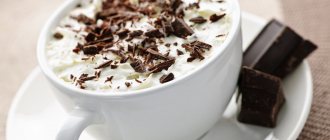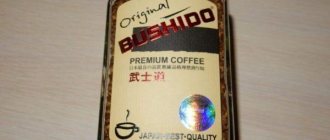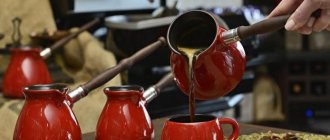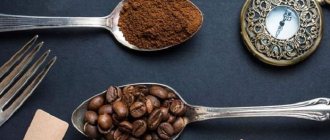Coffee is an aromatic, invigorating drink loved by many. It rightfully takes its place as one of the most popular in the world, as all kinds of cocktails are prepared from it. If you are used to drinking exclusively espresso or Americano, you will be interested in learning more original coffee recipes.
Below are relatively simple recipes for drinks that can be found in city coffee shops, but the list also includes exclusive cocktails that you are unlikely to find in the regular establishments you are used to visiting.
Cappuccino
Cappuccino means “Capuchin” in Italian, as it was invented by the Capuchin monks. The main component of cappuccino is espresso, the second is milk. It is important that the milk is foamed, but certain conditions must be met: the foam must be fine, dense and uniform.
The cappuccino temperature should be between 65-70°C. At this temperature, the cup does not burn your hands, and the coffee does not burn your tongue. A coffee machine with a cappuccino maker will help you prepare a drink at the required temperature.
The natural sweetness of milk and the bitterness of espresso should be harmoniously balanced. The taste of the foam should be creamy sweet. Cappuccino is not just coffee with milk, but a real pleasure under a lush cap of milk foam.
Brazil
In this country, both young and old drink coffee. True, it is given even to small children, but in the morning and only with milk - until they are 10 years old. Then young Brazilians drink this drink just like adults - that is, black, strong and very sweet. Serve it at any time of the day, not just for breakfast. As a snack, you can try brigadeiro - a national Brazilian dessert in the form of small cakes made from butter, cocoa, condensed milk and crushed chocolate. The taste of brigadeiro is not cloying, so this dessert goes well with coffee.
Brigadeiro has a very delicate texture and is covered with a thin chocolate crust on top.
Americano
If you dilute classic espresso with hot water, you get an Americano .
How did this type of coffee come about? During World War II, American soldiers looked to Italy for their traditional filter coffee, so Italian baristas decided to dilute the espresso, resulting in a completely new drink.
To prepare an Americano, you must first brew 50-60 ml of classic espresso from 14-16 g of coffee. It is very important not to brew coffee in the machine for more than 20-25 seconds. Then the resulting espresso must be diluted with the same amount of water heated to boiling.
Espresso is the basic basis of coffee drinks
Many popular coffee recipes are based on espresso - concentrated black coffee, which is brewed in a special coffee machine. The name “espresso” itself speaks volumes, primarily about the method of its preparation. The rich taste of this type of coffee drink is achieved as follows: through 6-7 grams of well-roasted, finely ground coffee, water is passed under high pressure, heated to almost a boiling point - 92-95 degrees. The total amount of the resulting drink should be 30-35 ml.
Video on the topic
Secrets of Italian coffee
Click Play to view
The strength of the espresso can also be varied by adding different amounts of water or using more ground coffee. In this regard, several varieties of espresso can be distinguished: Americano, Doppio, Lungo, Ristretto.
- Americano is a popular option for making espresso; the ratio of coffee concentrate and water (90-120 ml of hot water is added to 30 ml of espresso) allows you to achieve a rich but mild taste.
- Doppio is a classic shot of espresso doubled. A kind of “double esperso”.
- Lungo is probably the middle option in terms of strength of a coffee drink between classic espresso and Americano. For 7 grams of ground coffee used in this espresso preparation option, there are 50-60 ml of water.
- Ristretto is the strongest variety of espresso. This is caused by an increase in the concentration of the coffee itself and a decrease (compared to a regular serving of espresso) in the volume of water. The following proportion is maintained here: 7 grams of coffee per 20-25 ml of water. This type of espresso is especially loved by Italians - it is considered the most concentrated and is served with a glass of chilled water.
The espresso shot is small in volume, but quite strong in caffeine content
Brive
From Italian, brive is translated as “short”, but this name is not entirely correct. In fact, it should be called "creamy."
Wikipedia gives the following description of Brive coffee: an American variety of latte or cappuccino, a milk-based espresso drink. Instead of pure milk, a mixture of milk and cream is used in a ratio of 50 to 50. The use of such a mixture increases the foam in the drink.
Whether brive is a latte or a cappuccino, once you try this smooth, creamy coffee, you probably won't want to go back to the standard milk version. However, everyone has different tastes...
Coffee with milk
It is a portion of coffee mixed with hot milk.
For the first time , coffee with milk began to be prepared in France, using black coffee and preheated milk. After espresso machines became widespread in the 1940s, café au lait began to be made from espresso.
In France, this drink is usually served in a wide ceramic bowl, while in America it is served in a standard coffee cup. The American version of café au lait uses black coffee prepared using the drip method and steamed milk.
Regardless of the preparation method, this type of coffee is worth trying.
Palette of coffee flavors: milk, cream, sugar
Despite the pronounced and rich taste, many coffee lovers are not averse to diversifying the recipes for preparing this drink with additional ingredients. Among the most used and loved ones, of course, are derivatives of dairy products: milk, cream, milk foam.
Interesting to know! The easiest way to soften the taste of coffee is to add a little milk to it.
Americano with milk. The classic recipe for the proportion in this case is as follows: 50 ml of milk is mixed with 50 ml of water and 30 ml of espresso. The result is a classic 130 ml cup of Americano.
You might be interested in Riga coffee
Café con Leche. Literally translated as “coffee with milk.” A very simple and popular recipe in Spain and Portugal. Prepared coffee (in any form - espresso, double espresso) is mixed with milk in a 1:1 ratio. Popular options for making coffee using frothed milk and cream. You can complicate the recipe a little by adding specially processed milk or cream to coffee drinks. Milk can be whipped with steam in a coffee machine, cream can be whipped with a mixer until it becomes a thick, homogeneous mass that retains its shape well.
Cappuccino (Cappuccino). This recipe involves adding hot milk to the coffee. This is a fairly large drink in volume - 150 ml. When preparing a cappuccino, all its components (espresso, milk, milk foam) are mixed in a one-to-one ratio. The classic version is to add 40 ml of milk and the same amount of milk foam to 40 ml of espresso.
Cappuccino has whipped foam
Latte (Latte). To prepare this type of coffee with milk, Mocha coffee beans (one of the varieties of Arabica) are used. It uses the same ingredients that are used to make cappuccino, but the proportions in this case will be slightly different. For one part espresso, take two parts milk and one part milk foam. This drink is served in a tall glass.
Latte Macchiato (Latte Macchiato). The so-called “striped coffee”. A very interesting option for making coffee in terms of appearance and taste. Due to the fact that during the preparation process, coffee is poured into milk (through a layer of milk foam) and not vice versa - as in the case of preparing a classic Latte, the drink is stratified, forming three distinct layers - milk, coffee and milk foam. Served in a tall glass goblet with a straw, this coffee looks incredibly impressive.
Video on the topic
Cold coffee
Click Play to view
Con-Panna
Con Panna is a transliteration from Italian that translates as “with cream.” This drink is traditionally based on espresso, topped with whipped cream. The kon panna looks quite appetizing.
The espresso itself is prepared as usual: in a coffee machine. Cream can be prepared in two ways: the first is to whip it by hand, which is more like a tribute to tradition. The modern method of preparing cream is to squeeze it out of a can, at the same time giving it an aesthetic, intricate shape.
The main advantage of kon pann is that it is quick and easy to prepare, looks great and tastes equally great.
Corretto
Corretto is an Italian drink based on strong coffee and liqueur.
Espresso is often used as strong coffee, and instead of liqueur, brandy, sambuca or grappa can sometimes be added. Therefore, when we talk about corretto , we mean coffee mixed with a strong alcoholic drink.
In other countries such as Sweden and Norway there is a similar drink called carajillo. In Spain it is often served for breakfast.
Preparing corretto is very simple: brew ordinary espresso, add liqueur and a little sugar - our drink is ready!
We are looking for ideas for signature drinks
Where might the idea for a signature drink come from? Here are some ways.
- Listen to the wishes of visitors. This way you can understand the direction of work. It’s difficult to come up with a new drink this way, but you can find out what signature drinks in other coffee shops visitors like.
- Visit other coffee shops. I'm not advocating repeating their recipes, but some interesting flavor combinations may inspire you to create something new.
- Experiment. Mix foods in interesting combinations. It is advisable to use ingredients that are already in the coffee shop, so creating a new drink will not lead to additional costs and the need to purchase additional raw materials.
Fredo
Don't like too strong and hot coffee? Then Fredo is perfect for you. It can be called a cocktail, since Fredo is a mixture of coffee, milk and syrup.
To make a glass of Fredo, you first need to brew a shot of espresso using about one and a half times more water than usual. Then pour the prepared coffee into a mixing vessel and add not too rich milk and syrup (caramel, for example, is suitable, but in no case fruit). Throw in some ice and shake well. Your Fredo is ready!
It is worth noting that this drink helps you wake up well and even improves digestion, so it can be consumed after meals.
Latte
The name of the Italian coffee latte means “coffee with milk”. As the name suggests, the main ingredients of this drink are espresso and milk. In Italy, lattes are often prepared at home using mocha coffee (a type of Arabica) and warmed milk.
The finished shot of espresso is poured with hot milk and then topped with a layer of pre-foamed milk. Latte looks very similar to cappuccino, but differs from it in the ratio of coffee and milk.
And the main difference a latte and French café au lait is the mandatory use of espresso instead of black coffee or Americano.
Author's drink recipe
There are 3 stages in the development of a signature drink.
The basis
First you need to decide on the basis of the drink.
1. Will the drink be cold or hot? Here we should partially focus on the upcoming season. In winter, cold drinks are practically not taken, but in summer, refreshing chilled drinks will come in very handy.
Cold drinks are made by using ice cream or ice. Hot by beating the base in a steamer or adding boiling water.
2. Will the drink be coffee? That is, will there be espresso in the recipe? Espresso always goes well with milk or cream, but the combination with juice often makes the drink bitter.
3. The main component of the drink. Water? Milk? Juice? Cream? Plant milk? Sometimes the base may consist of a mixture of these liquids. For example, to create a non-alcoholic pina colada, milk is mixed with pineapple juice.
Additional Ingredients
After we've dealt with the base, we move on to additional ingredients that will make the drink special. What can I add?
- Spices. Cinnamon is the most traditional option. Muscat has an interesting and specific taste that does not go well with everything. Hot peppers go well with Americano, but milk can curdle when heated. Cardamom has proven itself well.
- Syrups . Adding syrup is the easiest way to tilt the flavor in the desired direction and add sweetness.
- Halva.
- Honey.
- Ice cream.
- Cocoa.
- Processed cheese.
- Melted chocolate (milk, dark, white).
- Protein.
In general, everything that is enough for your imagination.
It is important that the additional ingredients combine well with the base and mix (if the drink is not layered).
Lungo
lungo from Italian as “long,” it becomes clear that brewing this coffee takes longer than brewing standard espresso.
To prepare lungo, you need to take coffee from varieties with a delicate aroma and delicate taste. You need to fill it with more water (about twice as much) and cook longer. Unlike Americano coffee, which simply adds water, Lungo uses all the water through the ground coffee.
The taste of lungo is more bitter due to the fact that the water releases components that do not have time to be extracted when preparing espresso, but at the same time such coffee turns out to be less strong.
Macchiato
Macchiato is a type of espresso-based drink in which, unlike cappuccino or latte, coffee is poured into milk.
The word " macchiato " is translated from Italian as "spot". This dark coffee spot forms on top of the milk foam after pouring espresso into hot milk.
To properly prepare a macchiato, you need to whisk about 70 ml of milk, pour the resulting milk into a tall glass and then slowly and carefully pour freshly brewed espresso coffee into the milk.
Coffee macchiato is different in that the coffee is obtained in the middle, since the milk does not allow it to reach the very bottom of the glass, and a light milk foam ends up on top. Both beautiful and tasty!
Vietnam
Another country where dessert and coffee turned out to be one dish. In Vietnam they make egg coffee, which is, of course, coffee, but also sugar, condensed milk... and egg yolk! They say that the coffee tastes absolutely amazing, although the consistency is more like something between a drink and a dessert.
Although the egg coffee recipe is traditionally associated with Asia, a similar drink is also found in Norway
Mocha
When it comes to mocha , many people call it “chocolate coffee.”
Mocha is based on espresso, to which foamed milk and chocolate syrup are added. On top of this mass is covered with a cap of whipped cream, sprinkled with chocolate chips or chocolate topping. It should be noted that the coffee should not be visible from under the cream cap.
The taste of mocha is more dominated by a chocolate-creamy aroma than a coffee one. And the temperature of the finished drink is not very high, since the syrup and cream are added to the mocha cold.
This drink will be ideal when you want both coffee and sweets.
Türkiye
In this country, coffee beans are ground very finely before brewing, brewed over low heat and drunk from small cups just as leisurely. Usually sugar is added to coffee, sometimes it is drunk with Turkish delight - an oriental sweet like soft candies with the addition of fruit juices or nuts. Even in Turkey, you can be served kadaif with coffee, which resembles densely packed vermicelli. Its actual ingredients are sherbet, nuts and a thread-like dough.
Kadaif is often topped with whipped cream and can be served with jam.
Ristretto
Ristretto can rightfully be called the strongest, bitter and invigorating coffee drink.
The reason for this taste lies in the preparation method: for ristretto , a smaller volume of water is used than for espresso. Usually this is 7 g of coffee beans per 15-20 ml of water.
Many people believe that ristretto has too much caffeine, but this is a misconception. During the first few seconds of brewing, essential oils are released from the coffee, giving it a rich taste, and caffeine enters the drink later. Because of this, ristretto usually has even less caffeine than espresso.
A serving of this drink is usually designed for 1-2 sips, so Italians often drink it without leaving the bar.
Romano
Translated from Italian, “ Romano ” is translated as “Roman”, although such a coffee drink is prepared everywhere. A distinctive feature of Romano is the presence of a pronounced citrus aroma.
Making this drink is quite simple: you just need to add a slice of lemon to a freshly brewed cup of espresso. Sometimes instead of a lemon wedge, lemon zest cut into strips is used. And some people prefer to squeeze out 5 ml of lemon juice and then add it to the finished espresso.
In any case, Romano has good tonic properties and an invigorating effect.
Cuban coffee
Cuban coffee or Cuban coffee , as the name suggests, first appeared in Cuba when the first Italian espresso machines were brought into the country. Cuban coffee is based on espresso, but Cubans then dilute it with 15-30 ml of water, which makes it less strong.
Cuban coffee also differs in that 1 tablespoon of cane sugar is poured into the cup before pouring the finished espresso. This results in the espresso acquiring a specific sweet taste.
When preparing coffee this way, you can get light brown or creamy cream.











